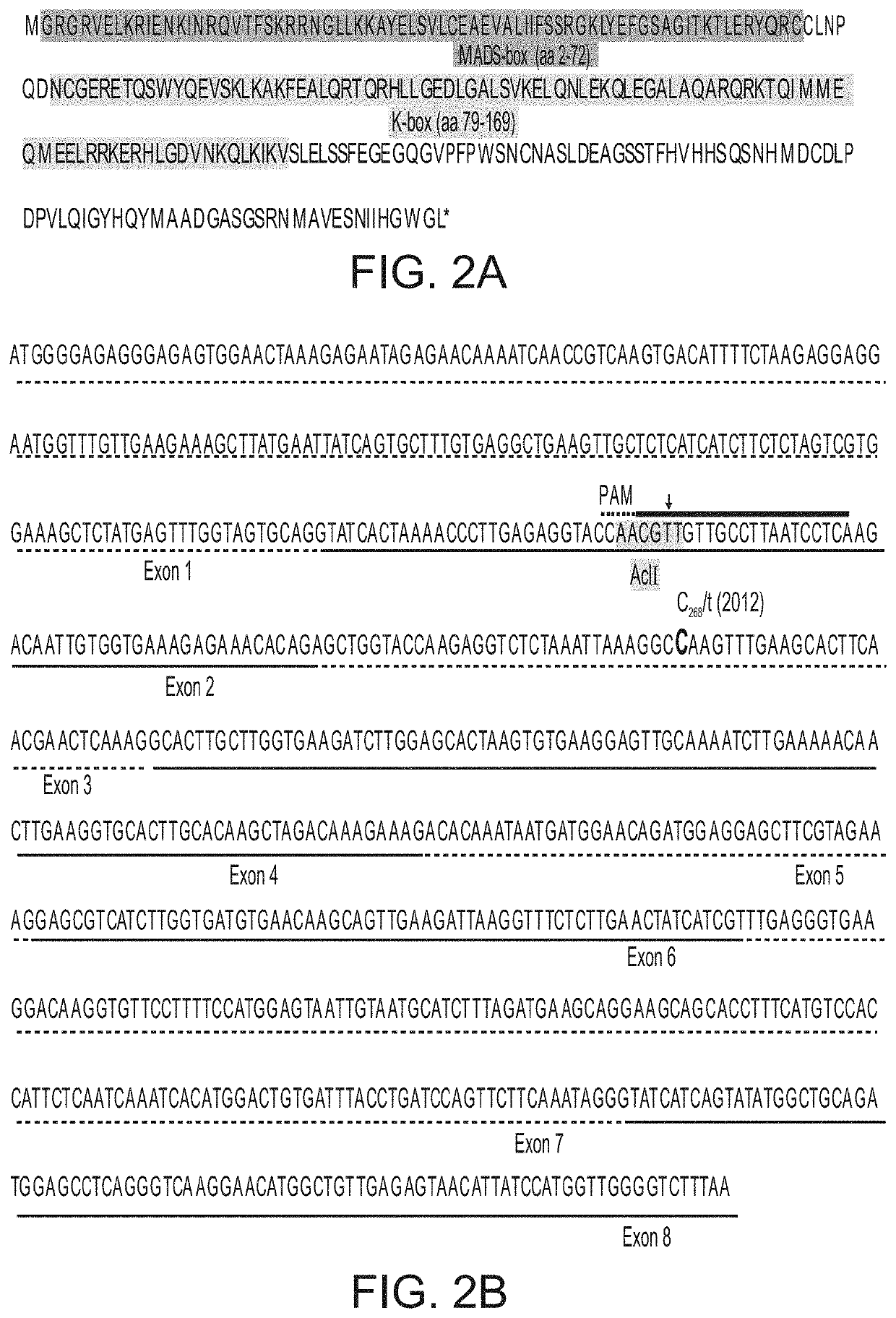Parthenocarpic plants and methods of producing same
a technology applied in the field of parthenocarpic plants and methods of producing same, can solve the problems of limiting the exploitation of mutants in breeding programs, and affecting the success rate of the breeding program
- Summary
- Abstract
- Description
- Claims
- Application Information
AI Technical Summary
Benefits of technology
Problems solved by technology
Method used
Image
Examples
example 1
Identification of Line 2012 as a New Monogenic Recessive Mutant for Parthenocarpy Derived from EMS Mutagenized M82 Population
[0262]A chemically mutagenized M2 population generated in the M82 cultivar, by imbibing seeds in EMS solution (population generated by J Hirschenhoren and Y. Kapulnik, The Volcani Center, ARO) was screened for mutants yielding under extremely high temperatures, as described in Materials and Methods. Family No. 2012 included two plants, each coming from a different replicate (see in Materials and Methods), that set nice parthenocarpic fruits with good jelly under these conditions, whereas the parental line plants set at the most some tiny, hollow “nuts” fruits.
[0263]The pollen of one of these two plants served in pollinating emasculated flowers of M82 plant, which set seeded fruits. These BC1 plants were not parthenocarpic. However 7 out of 40 BC1F2 progenies set seedless fruits under the extremely hot conditions prevailing in the late summer of 2010, when the ...
example 2
NGS Assisted Mapping of the 2012 Mutation
[0264]To map the mutation, the bulk segregation approach (Michelmore et al 1991) was chosen. Deep sequencing was performed on two genomic libraries one coming from a bulk of 2012 BC1F2 parthenocarpic siblings and the other from their non-parthenocarpic siblings.
[0265]The facultative nature of the 2012 parthenocarpy together with plausible interaction with other EMS induced mutations affecting the manifestation of the trait could result in contamination of the parthenocarpic library with DNA derived from falsely phenotyped non-parthenocarpic sibling. Thus several measures were taken to try nullify this risk: First, 105 plants from the 2012 BC1F2 population were grown in the late summer of 2011 in a net house, since usually from mid-July to late August the temperatures are high enough to seriously damage microsporogenesis and hence prevent fertilization dependent fruit development. On Sep. 27, 2011 the fruits were harvested, examined, and each ...
example 3
Marker Assisted Refined Mapping of the 2012 Mutation
[0267]In attempt to restrict the location of the mutation underlying the 2012 mutant, co-segregation of six SNPs dispersed along the chromosomal interval suggested as the mutation location (Table 1, column 2), with the parthenocarpic phenotype was examined in a test cross (TC) population, (Generated as described in Materials and Methods). This population was allowed to set fruit under heat stress, late in the summer of 2013. Genotyping of the TC population for each of the six candidate SNPs specified in Table 1, column 2, was performed as a service by DYN R&D, Israel. (see Materials and Methods).
[0268]Table 2 summarizes the phenotyping and genotyping results of this TC population for the six point mutations. This analysis indicated that SNPs No. 1,5 and 6 are not linked to the mutation. On the other hand, for SNPs No. 2, 3 and 4, a tight, though not absolute, link was found between the mutations and the phenotype (Table 2). This an...
PUM
| Property | Measurement | Unit |
|---|---|---|
| Fraction | aaaaa | aaaaa |
| Fraction | aaaaa | aaaaa |
| Fraction | aaaaa | aaaaa |
Abstract
Description
Claims
Application Information
 Login to View More
Login to View More - R&D
- Intellectual Property
- Life Sciences
- Materials
- Tech Scout
- Unparalleled Data Quality
- Higher Quality Content
- 60% Fewer Hallucinations
Browse by: Latest US Patents, China's latest patents, Technical Efficacy Thesaurus, Application Domain, Technology Topic, Popular Technical Reports.
© 2025 PatSnap. All rights reserved.Legal|Privacy policy|Modern Slavery Act Transparency Statement|Sitemap|About US| Contact US: help@patsnap.com



